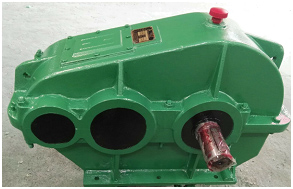The difference between hard tooth surface reducer and soft tooth surface reducer

WPWDT40,WPWDT50,WPWDT60,WPWDT70,WPWDT80 Hard tooth surface reducer is a relatively high-precision mechanical equipment, which is used to reduce the speed ratio and increase the torque. It is suitable for fast shaft speed ratio not exceeding 1500 rpm, gear transmission system circular speed not exceeding 20 meters per second, and office environment temperature conditions ranging from -40 ℃ to 45 ℃.
The soft tooth surface reducer is developed on the basis of the QJ series product's medium hard tooth surface reducer for lifting equipment. The QY series product reducer includes two series of products: QYS (three support points) and QYD (base type) hard tooth surface reducers for lifting equipment. It has three types: three levels, four levels, and three four level fusion The QY reducer adopts thick steel plate welding, the shell is quenched to solve internal stress, and the gears are made of high-quality low-carbon and environmentally friendly carbon steel. The tooth surface is carburized and quenched, and processed through cutting production. The product quality is stable and the performance is reliable.
The soft tooth surface of the reducer is generally a gear with a strength of<=350HBS, and the heat treatment methods include quenching and aging treatment. Hard tooth surfaces are generally gears with a strength greater than 350HBS. The heat treatment processes for obtaining hard tooth surfaces include overall heat treatment, induction quenching, carburizing quenching, and nitriding. After obtaining the soft tooth surface heat treatment process, the front teeth can be precision cut up to 7 levels. Because small gears bear more force frequency than large gears, in order to make size gears close to equal compressive strength, aging treated small gears are often matched with quenched large gears, so that the tooth surface strength of small gears is 30-50HBS higher than that of large gears. Hard tooth surface gears are generally treated with surface hardness after the front teeth, but in the heat treatment process, it is difficult to avoid deformation of the gear. Therefore, after the heat treatment process, cutting, grinding, or precision cutting must be carried out, with a precision of up to 5 or 4 levels to solve the deviation caused by deformation and improve the precision of the gear. However, with the development trend of new technologies for hard tooth surface production and processing, the use of hard alloy tool end mills or cobalt spring steel end mills can also precision roll shaft teeth without the need for further milling.
The tooth contact fatigue limit, tooth root bending fatigue limit, and tooth surface anti plywood working ability of the hard bottomed gear of the reducer have all been improved. Therefore, choosing hard or harder tooth surfaces is a rapid development trend at present. Previously, the consideration of hard and soft tooth surfaces was mainly due to the lack of production and processing technology. However, in most cases, production and processing standards can be achieved, so there is not much emphasis on selecting hard and soft tooth surfaces as a key element. The performance of hard tooth surfaces is generally much higher than that of soft tooth surfaces. It's just that the cost is relatively higher.
-
2024-05-31The WPWD120,WPWD135,WPWD155,WPWD175,WPWD200 helical gear reducer is one of the indispensable key equipment in modern industrial production. It can stably reduce...Details +
-
ZJY180 hard tooth surface gear reducer
2024-05-31WPW155,WPW175,WPW200,WPW250,WPWD40 Gear reducer is a widely used mechanical equipment in various fields, and it is highly favored by users for its efficient and...Details + -
DCY355-40-1 Hardened bevel gear reducer
2024-05-30In various industries, the application of mechanical equipment is indispensable. In mechanical equipment,WPWDKV70,WPWDKV80,WPWDKV100,WPWDKV120,WPWDKV135 the...Details + -
Working principle of ZQ850-48.57-1 gear reducer
2024-05-30WPEEDO70-120,WPEEDO80-135,WPEEDO80-147,WPEEDO100-155,WPEEDO120-175 Gear reducers are indispensable power transmission devices in modern industrial fields, JZQ85...Details +







